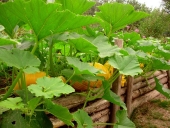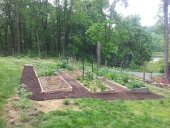posted 8 years ago
I think a lot of this really depends on:
(1) Aesthetics: what type of garden do you like the looks of? Do you life formal raised beds with straight lines, curving raised beds, or a mix?
(2) Water: Does it rain a lot all at once, or is it constantly drizzly, or is it dry during the summer or dry all year round? Each of those will lend itself to different types of garden beds and lay outs. You might want them on contour if you get very little rain, or off contour if you need drainage.
(3) Materials: What do you have available for building these beds, Different materials lend themselves to different beds?
(4) Plants: What are you wanting to grow? If you're growing a lot of plants with different sun/water needs, you might want some raised beds with drainage, or some keyholes to preserve water, or sunken beds for wetter growing areas, etc. It's okay to experiment with different garden bed styles! I have a keyhole, a herb spiral, a hugel/lazagna bed, two big hugelculture beds, gardenig around fruit trees, and a mulched potato bed.
A little more info about your climate will really help, even if it's just saying, "I'm Mediterranean zone 9 Australia" or "I'm tropical zone 11 in South America"








